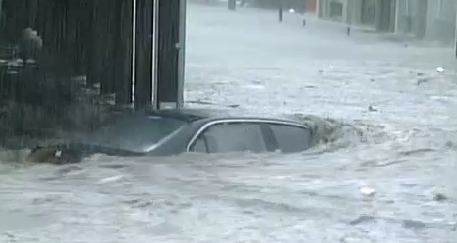Gaston sized storm would flood Shockoe again
It’s a storm that’s bigger than anything we could ever build and we realized that from the beginning that we were never going to build an infrastructure to make Gaston not happen again.

Yesterday was the 10 year anniversary of Gaston and the devastation it wreaked on Shockoe Bottom. One merely needs to go into Bottoms Up Pizza and see the line on the wall that shows how the water rose. It was terrifying for residents and devastating for many local businesses.
NBC12 takes a look at what has changed since then and what would happen if a storm like Gaston were to return. The answer is not what you want to hear but the good news is that Gaston was considered a “once in a thousand years” storm so we should be good for another 990 years.
“We can’t do anything about it,” he stated. “It’s a storm that’s bigger than anything we could ever build and we realized that from the beginning that we were never going to build an infrastructure to make Gaston not happen again. The things that we could build are not within the realm of possibility.” (Full video of story)
Image: NBC12
-
Recommend this
on Facebook -

Report an error
-

Subscribe to our
Weekly Digest




Notice: Comments that are not conducive to an interesting and thoughtful conversation may be removed at the editor’s discretion.
I think we should do what other cities have done, by gradually restoring to some extent the natural drainage of Shockoe Valley- meaning daylighting Shockoe Creek. I remember this being brought up again and again during the Master Plan charrettes.
http://news.nationalgeographic.com/news/2013/07/130730-daylighting-exposing-underground-rivers-water-urban-renewal/
Scott- how many of the underground waterways referenced in your link are combined sewer systems like the Shockoe Creek. It sounds like a great idea until we acknowledge that fact. How much would it cost to segregate the sewage line from what used to be a creek?
“In a combined sewer system, stormwater is the major culprit in combined sewer overflows (CSOs). That’s why MSD is exploring the use of sustainable stormwater solutions.
These solutions, also known as sustainable or green infrastructure, reduce CSOs by reducing the amount of stormwater runoff entering the combined sewer system. They can range from rain gardens and pervious pavement to stormwater detention basins and stream restoration (daylighting).
MSD is also exploring a unique concept called Communities of the Future that combines stormwater solutions with urban renewal in communities that experience frequent CSOs.”
http://projectgroundwork.org/index.htm
Hmm… that didn’t really answer my question. Project Groundwork is a $3B+ project. How much would it cost for Shockoe Creek?
Shockoe flooded many times long before the creek was covered up. I’ve read anecdotes of tavern patrons paddling a canoe up to a bar (located roughly where Main St. station is) and ordering drinks. That was in the 1700s. In the 1800s, Gabriel’s Rebellion was thwarted by a similar storm/flood. It’s a flood plain. It floods. That’s the risk of building there and that’s why anyone owning property there should buy flood insurance. The flood wall and CSO system reduced premiums, making the bottom more business friendly. Whether any of that infrastructure actually works is irrelevant. Floods have always happened in the Bottom and as long as we don’t dam the James upstream, it always will.
Owen, I would like to know the answer to that question. Project Groundwork covers a much bigger area than Shockoe Valley.
Dustin, it has always flooded, but the point of daylighting the creek would be to diminish the effect on surrounding areas. An open creek could be used to better manage flooding.